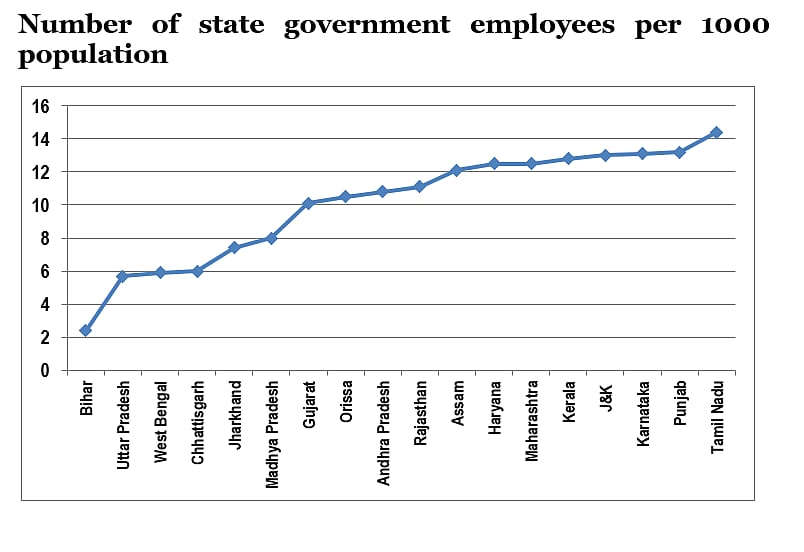High salary but not that high quality service: What ails the IAS?
Not even ‘minimum government and maximum governance’ has succeeded in ensuring the desired delivery of services and reforms

GOI Ministries transfer more than 2.5 lakh Crore Rupees every year to the states. Evidence suggests that many state governments, especially the poor ones, are neither able to draw their entitled funds from GOI, nor are able to release these to the districts/villages in time, with the result that GOI is often constrained to divert the unclaimed funds to better performing states.
An evaluation of ICDS in Bihar in 2007 by UNICEF showed that only less than 10% of grassroot workers received honorarium regularly, most received it only twice in a year rather than monthly. Another study showed that only 18% of officials in Jharkhand working at the grassroots level are paid their salaries in time.
GOI’s own studies show that even electronic transfer takes months with the result that in Mid-Day Meals programme ground staff such as cooks and helpers are not paid for months, FCI withholds supply of grain, and mid-day meals are served only for 60-70% working days in some states.
Similar delays take place in supply of text books in SSA, filling up of vacancies, especially in the remote and tribal areas, capital works, funds for maintenance, etc. For RMSA (Rashtriya Madhyamik Shiksha Abhiyan), a programme for secondary education, in FY 2015-16 only 39 per cent of the approved budget was spent. This decreased further to 36 per cent in FY 2016-17.
The Pradhan Mantri Matru Vandana Yojana (PMMVY), is a maternity benefit scheme providing conditional cash transfers to pregnant women and lactating mothers for the first live birth. On 31 December 2016, the Prime Minster announced the pan-India implementation of this programme. While the eligible population is estimated at 130 lakh, only 20 per cent of the beneficiaries could be enrolled in FY 2017-18 and 27 per cent in FY 2018-19.
Poor States lack manpower for better delivery
The reason for poor performance by Bihar, Orissa, UP, and MP is often the widespread shortage of staff at all levels that adversely affects implementation and supervision of programmes. Insufficient revenues with the poorer states result in not only weak infrastructure, such as schools without buildings and deficient power generation, but also in inadequate number of government staff.
Number of government servants per 1000 population was 2.7 in Bihar as compared to 14.4 in Tamil Nadu. State-wise position is given in Figure below.

This in turn affects these states’ capacity to draw tied plan funds from GOI Ministries or submit utilisation certificates in time. Thus, shortage of staff results in weak governance that further limits their access to GOI resources; each factor being the cause as well as the effect of the other resulting in a vicious cycle.
There are too many government servants in the support positions, such as clerks, orderlies, and drivers, who are now not needed and too few people in the line positions, such as teachers, nurses, and policemen, who can deliver public services. So, people who are needed in the line positions are missing while people who are not needed in support positions are too many. There should be incentives for clerks and class IV staff to become teachers and constables.
Finally, salaries of regular government staff as a multiple of per capita income is highest in India when compared with other countries.

Pay increases in India are not intended to serve as a reward for increased productivity, but are given instead to gain support from the unions and to eliminate the threat of labour unrest. Moreover, government servants manage election booths, and no political party can afford their collective anger.
High salaries have unfortunately not resulted in better outcomes, as field staff is either absent from duty or gets away by reporting inflated data.
Rampant absenteeism and bogus reporting
The bulk of expenditure in education and health typically flows to the salaries of teachers and health workers, yet widespread absenteeism means that services are not effectively provided. Teacher absenteeism, particularly in the north, is endemic, with almost two-thirds of government teachers either absent or not teaching at the time of the investigators’ unannounced visits.
A study by the Planning Commission had found that on surprise inspection in Bihar and Rajasthan just a quarter of doctors were physically on duty at the Community Health Centres (CHCs - these operate at the sub-district or block level). Absenteeism is rampant though seldom measured.
In effect, governments use tax revenues to provide (quantifiable) high salaries rather than (less quantifiable) high quality services. The system exists for the service providers but not for service provision. This weakness of administration hurts the poor and denies them basic services.
Follow us on: Facebook, Twitter, Google News, Instagram
Join our official telegram channel (@nationalherald) and stay updated with the latest headlines
